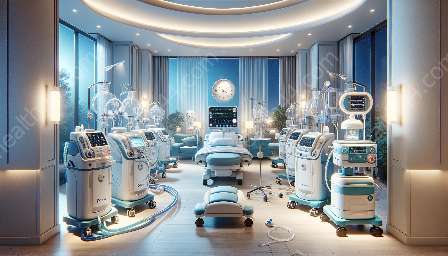Oxygen therapy equipment plays a crucial role in the field of respiratory care, as well as in the broader landscape of medical devices and equipment. This topic cluster will delve into the significance, types, and advancements in oxygen therapy equipment, examining its compatibility with respiratory care devices and medical devices.
Understanding Oxygen Therapy Equipment
Oxygen therapy is a medical treatment that involves delivering oxygen to individuals who have difficulty breathing or who need additional oxygen due to certain medical conditions. Oxygen therapy equipment is designed to administer oxygen effectively and efficiently, helping patients maintain adequate levels of oxygen in their bodies.
The primary objective of oxygen therapy is to increase the amount of oxygen delivered to the lungs and subsequently to the bloodstream, thereby improving overall oxygenation and alleviating respiratory distress. This can be achieved through a variety of oxygen delivery devices and systems, which are integral to respiratory care and medical devices & equipment.
Types of Oxygen Delivery Devices
Oxygen therapy equipment encompasses a range of devices and systems, each tailored to meet specific patient needs and clinical requirements. Some common types of oxygen delivery devices include:
- Oxygen Concentrators: These devices extract oxygen from the air, remove impurities, and deliver purified oxygen to the patient through a nasal cannula or mask.
- Oxygen Cylinders: Portable tanks that contain compressed oxygen, often used for short-term or emergency oxygen therapy.
- Oxygen Masks: Designed to cover the nose and mouth, delivering oxygen directly to the patient's airways.
- Nasal Cannulas: Tubing with prongs that fit into the patient's nostrils, enabling the delivery of oxygen without covering the face.
- Venturi Masks: Provide precise oxygen concentrations by mixing oxygen with room air through a venturi system.
- High-Flow Nasal Cannula (HFNC) Systems: Deliver high flows of respiratory gas and are capable of providing warmed and humidified oxygen.
- Non-invasive Ventilation Devices: Deliver oxygen under positive pressure without the need for intubation, aiding patients in respiratory distress.
These oxygen delivery devices are essential components of respiratory care, playing a vital role in managing a wide range of respiratory conditions, from chronic obstructive pulmonary disease (COPD) to acute respiratory distress syndrome (ARDS).
Integration with Respiratory Care Devices
Oxygen therapy equipment seamlessly integrates with various respiratory care devices, which are designed to monitor, support, and improve respiratory function. Ventilators, pulse oximeters, nebulizers, and spirometers are just a few examples of respiratory care devices that work in tandem with oxygen therapy equipment to provide comprehensive care for patients with respiratory issues.
Ventilators, for instance, are critical in delivering controlled amounts of oxygen and air to patients with compromised lung function, and they can be coupled with oxygen therapy equipment to optimize respiratory support. Similarly, pulse oximeters are used to measure the oxygen saturation in the blood, providing valuable data to guide the administration of oxygen therapy and assess its efficacy.
Furthermore, nebulizers are often employed to deliver medication directly to the airways, and they can be combined with oxygen therapy equipment to ensure effective delivery of both oxygen and prescribed medications to patients with respiratory conditions.
Advancements in Oxygen Therapy Equipment
Ongoing advancements in technology have led to the development of innovative oxygen therapy equipment that enhances patient comfort, improves clinical outcomes, and streamlines the delivery of oxygen therapy. One example is the emergence of portable and lightweight oxygen concentrators, offering greater mobility and flexibility for patients who require continuous oxygen therapy.
Additionally, the integration of advanced sensors and algorithms into oxygen delivery devices has enabled more precise and personalized oxygen therapy, ensuring that patients receive the optimal levels of oxygen based on their individual needs and physiological responses.
Furthermore, the incorporation of telemonitoring capabilities in oxygen therapy equipment allows healthcare providers to remotely monitor patients' oxygen saturation levels and usage patterns, facilitating proactive interventions and personalized adjustments to the prescribed oxygen therapy.
Conclusion
Oxygen therapy equipment serves as a cornerstone of respiratory care and medical devices & equipment, playing a pivotal role in addressing the diverse needs of patients with respiratory conditions. Understanding the different types of oxygen delivery devices, their integration with respiratory care devices, and the ongoing advancements in oxygen therapy equipment is essential for healthcare professionals and individuals seeking optimal respiratory support and management.


